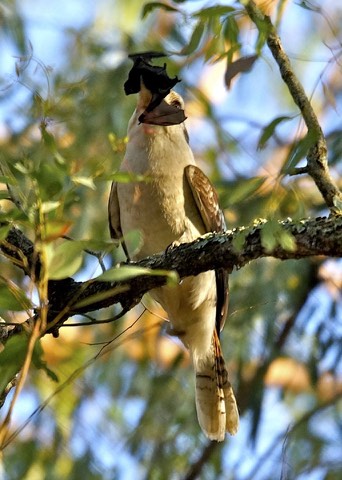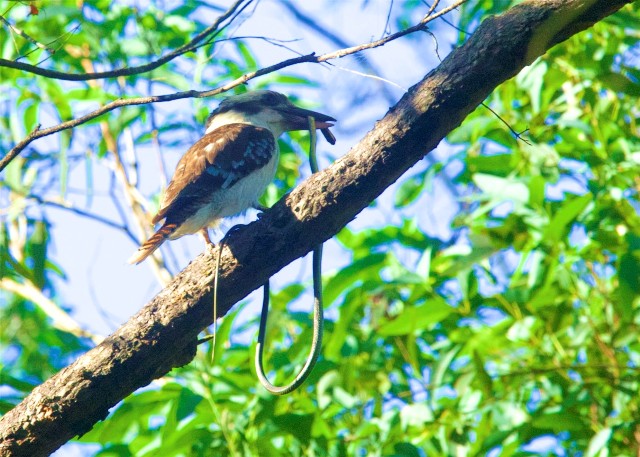The steep hill behind our home runs north-south between the valleys of Gold Creek and Savages Roads. There is a continuous run of vegetation from our place past the Gold Creek Reservoir through to the Enoggera Forest Reserve.
I go up the hill just after day break for two hours nearly every day as it has been a where I found several birds that have been rarely seen or even new additions to the Moggill Creek Catchment bird list.
It is where I found the Hooded Robin, Paradise Riflebird, Oriental Cuckoo including the rare hepatic morph, Barred Cuckoo-shrike, Wompoo Fruit-dove and several other interesting species. In fact, it was up on the hill that I laid claim to the first sightings in our catchment of the Superb Fruit Dove and Red-capped Robin. (Click on the links to read about these sightings back in 2017.)
I believe the ridge with its tall Ironbarks and Spotted Gums is a stopping off point for birds doing their North-South Migrations as many of my sightings of rare birds have been in the Autumn and Spring months.
Chance encounters with these birds as they are flying through don’t happen every day so it involves a lot of patient observing, but is far from boring. There are plenty of resident birds and I have been lucky to observe some interesting behavior while watching for the rarities.
One day I had four fully coloured Red-backed Fairy-wrens showing off to a group of females. Two of them were trying to out smart their rivals by holding in their beaks the petals of the wild Red Salvia that was flowering in the area. I assume that the females go with the male that has the most bright red.
I have had my most exciting encounters with raptors at the top of the hill as they fly much closer, often even between the trees. The resident Wedgetail Eagles are huge and spectacular that close and I’ve also had memorable close encounters with a White-shouldered Kite, a close-up of a Pacific Baza eating a Giant Stick Insect, a Square-tailed Kite, a Peregrine Falcon, a nesting pair of Grey Goshawks and a pair of Sparrowhawks.
One old tree is the regular nesting hole for a pair of Wood Ducks. The eggs are laid in a hole 15m high and they come back every day at the same time when the female lays another egg while the male sits in a nearby tree making soft noises that I never hear them making any other time. I fantasize one day I’ll be lucky enough to photograph the newly hatched ducklings jumping down 15m just like they do in Attenborough films.
One of the most interesting encounters was with a Kookaburra. They are always present, but this day this one seemed to behaving rather differently. I trained my camera on it because nothing better was around. What he was watching was a bat it had disturbed that was flying around erratically between the trees. I had never realized a Kookaburra could move so fast because next thing he had it in his beak.
I looked up the Kookaburras in the ultimate bird reference book, Handbook of Australian, New Zealand and Antarctic Birds (HANZAB) and it was interesting to read of the wide range of insects, snails, birds, snakes, small mammals and frogs Kookaburras eat. But HANZAB only reported “unconfirmed report of eating bats”. Well now it is confirmed!


HANZAB says snakes over 1.2m haven’t been confirmed as prey.
This one would be close to exceeding that. It flew off so I never saw if it managed to eat it!
Another activity I have at the crest of the hill is watching the male butterflies of a number of species Hilltopping. This is the term the Butterfly enthusiast refer to when the males, after they have had a feed on the flowers lower down, move to the top of the hill and search for females that come up to mate. They seem to never stop flying which is a problem for photography, but interesting to watch!
Luckily we have both the Eastern and Western sides of the ridge and I have found that the butterflies and the birds tend to move sides depending on which is the sheltered one.
I am almost always accompanied by the Red-necked Wallabies and I occasionally hear the thump of a Pademelon. Echidnas and bandicoots are present too, but I only see their burrowings during the day.
The ridge always has a story to tell and it is a very peaceful (apart from the wonderful dawn chorus) and relaxing way to start the day.

